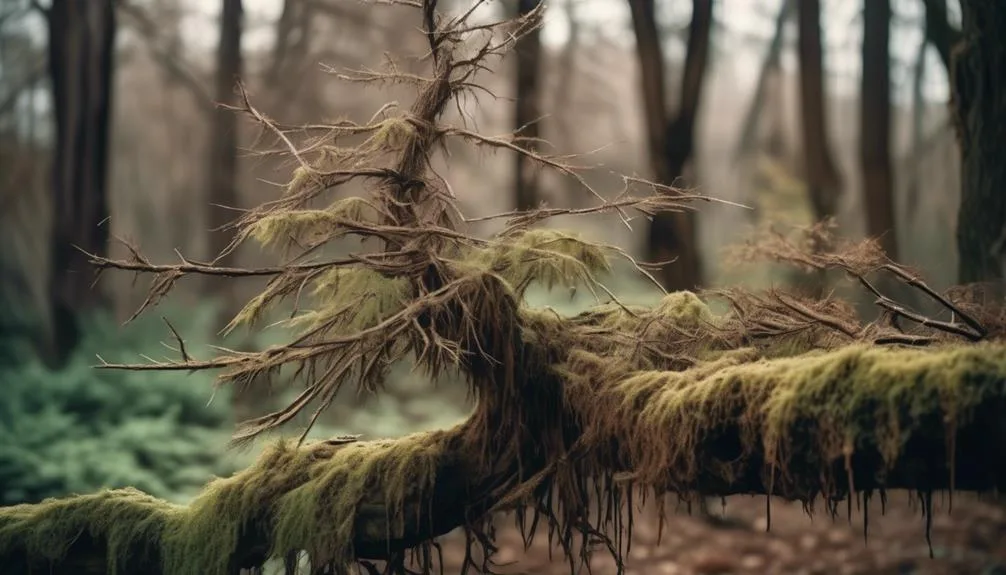Cedar trees can live for centuries, but if yours is showing signs of decline, there's hope. With the right care, it's possible to revive a struggling cedar tree and bring it back to health.
Whether you're an experienced gardener or new to tree care, understanding the common issues affecting cedar trees and the methods for reviving them can make a big difference.
Stay tuned to learn more about saving your beloved cedar tree.
Signs of a Dying Cedar Tree
If you notice yellowing or browning of the foliage, along with brittle or peeling bark, these are common signs that your cedar tree may be in distress and potentially dying.
Early intervention is crucial when dealing with ailing cedar trees. Environmental stressors such as extreme weather conditions, soil compaction, or pests can take a toll on these majestic trees.
It's important to carefully inspect the tree to identify any signs of distress early on, as this can greatly increase the chances of successful revival. Look for any changes in the color and texture of the foliage, as well as any unusual patterns of bark peeling or brittleness.
Understanding these signs and addressing any issues promptly can make a significant difference in saving your cedar tree from potential demise.
Identifying Common Cedar Tree Issues
When a cedar tree shows signs of distress such as yellowing or browning foliage and brittle or peeling bark, it's important to identify the common issues that could be affecting its health. Here are some common cedar tree issues to look out for:
- Pest Infestation: Keep an eye out for common pests like cedar bark beetles or spider mites, which can cause significant damage to cedar trees.
- Fungal Diseases: Diseases like cedar apple rust or root rot can affect the health of cedar trees, leading to discoloration and decay.
- Soil Health: Poor soil drainage or nutrient deficiencies can impact the tree's overall health. Ensure the soil is well-draining and consider using fertilizers specifically formulated for cedar trees.
- Pruning Techniques: Improper pruning can stress the tree and leave it vulnerable to diseases and pests. Learn proper pruning techniques to maintain the tree's health and shape.
Identifying these issues early on can help address them effectively and improve the overall health of the cedar tree.
Proper Cedar Tree Care and Maintenance
To ensure the health and vitality of your cedar tree, consistent and proper care and maintenance are essential.
Cedar tree pruning is crucial for removing dead or diseased branches, promoting air circulation, and maintaining an attractive shape. Regular pruning also helps prevent the development of weak or overcrowded areas within the tree. When pruning, make clean cuts at a slight angle just above a healthy bud or lateral branch.
Additionally, proper cedar tree watering techniques are vital for its well-being. Water deeply and infrequently, allowing the soil to dry out slightly between waterings to encourage deep root growth. Mulching around the base of the tree can help retain moisture and regulate soil temperature.
Techniques for Reviving a Declining Cedar Tree
Reviving a declining cedar tree requires a careful assessment of its condition and the implementation of targeted interventions tailored to its specific needs. To help you revive your cedar tree, consider the following techniques:
- Soil Testing and Aeration: Conduct a soil test to determine the pH level and nutrient deficiencies. Aerating the soil around the tree can improve its overall health by enhancing oxygen and nutrient uptake.
- Watering: Ensure the tree receives adequate water, especially during dry periods. Deep, infrequent watering is preferable to frequent shallow watering.
- Fertilization: Use a balanced fertilizer specifically formulated for evergreen trees to provide essential nutrients and promote healthy growth.
- Pruning: Remove dead or diseased branches to encourage new growth and improve the tree's overall appearance.
Seeking Professional Help for Your Cedar Tree
If your efforts to revive your declining cedar tree haven't yielded the desired results, it may be time to consider seeking professional help to assess and address its specific needs.
Tree diagnosis is a crucial step in understanding the underlying issues affecting your cedar tree's health. Consulting with a tree care expert can provide valuable insights into the root cause of the decline and help determine the most effective course of action.
An expert consultation allows for a comprehensive assessment of the tree's overall health, including factors such as soil quality, pest infestations, diseases, and environmental stressors. With their specialized knowledge and experience, arborists can offer tailored solutions to revive your cedar tree and promote its long-term well-being.
Don't hesitate to reach out to a professional to give your beloved cedar tree the best chance for recovery.
Conclusion
With patience and proper care, your cedar tree can be revived to its former lush and vibrant state. By addressing the issues, providing the right care, and seeking professional help when needed, you can ensure a healthy and thriving future for your cedar tree.
Don't lose hope – there are still opportunities for revival and growth.
Mark Hoffman is a dedicated arborist and tree care specialist with over a decade of experience. His love for trees began when he visited Yosemite National Park as a teenager and was awestruck by the giant sequoias. Mark pursued his passion by studying forestry at Michigan Technological University, where he earned a Bachelor of Science degree.
Since then, he has worked tirelessly in the field of arboriculture, helping to preserve and protect trees in his community. His expertise and dedication have made him a respected leader in the industry and a valuable resource for anyone seeking advice on tree care.
